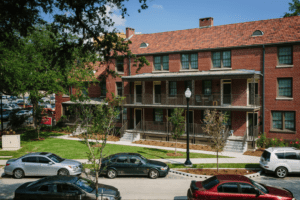Top Story
Ten Years after Katrina, ULI Louisiana Members Reflect on Progress in New Orleans
August 26, 2015
Hurricane Katrina wrought unprecedented destruction to an already ailing city. Before the category 3 storm touched down on the southeast Louisiana coast on August 29, 2005, and a levee system designed to protect it failed, New Orleans had been struggling with high crime and poverty rates. Its school system was abysmal, its job creation rate low, and its population in steady decline as residents fled to suburban parishes and other cities for better opportunities. Until Katrina threw the city into national view, New Orleans was widely considered more as a tourist destination than as a place to which to relocate and establish roots.
Ten years later, the story of New Orleans could not be more different than what it was before Katrina or in its immediate aftermath. It is now a talent magnet, with Forbes and other outlets ranking New Orleans at the top of their lists of best cities for creative people and millennials. In the years following the storm, young people from all over the country flocked to the city to take part in its recovery. Several thousand have stayed, and are now launching careers, restoring the city’s bungalows and cottages, and making their mark on neighborhoods.
New businesses and industries are taking off, while traditional ones are rebranding themselves. The city has become a hotbed of innovation and entrepreneurship, hosting the buzzy Entrepreneur Week every March and gaining attention for its burgeoning IT sector and startup culture. More than 1,500 residential units in downtown neighborhoods are coming on line in the form of new construction, historic rehabs, and conversions of office buildings into new apartments and condominiums. The city is now safeguarded by a new $14.5 billion flood protection system designed to minimize flooding from a 500-year storm event, while the state is working on a $50 billion master plan for coastal restoration of wetlands and natural systems to build resilience.
“I’ve lived in New Orleans for 51 years and I’ve been involved in the development of downtown,” says former ULI Chairman, longtime ULI Foundation Governor, and ULI Louisiana leader Joseph C. Canizaro, founder and chairman of Columbus Properties in New Orleans. “Economically, the city is better off today than since I’ve been in New Orleans.”

The Paramount NOLA apartment building in downtown New Orleans, one of the new developments catering to upwardly mobile professionals who moved to New Orleans after Katrina.
A Residential Boom Downtown . . . but Not Fast Enough Many trace the current prosperity of New Orleans back to the influx of federal dollars in Katrina’s wake. While nearly half of the $120.5 billion aid package went to recovery efforts, the remaining funds were funneled into rebuilding roads, housing, and critical infrastructure.
In addition, the Gulf Opportunity (GO) Zone Act of 2005 provided tax-free bonds to rebuild housing and businesses along the Mississippi Gulf Coast. In Orleans Parish, the GO Zone Act funded affordable housing as part of larger, mixed-income developments that replaced four major public housing complexes that were torn down immediately after Katrina. Other incentives—namely, low-income housing tax credits, historic tax credits, and New Markets Tax Credits—were powerful tools to lure private capital back to the city.
The timing of these federal subsidies was critical since they cushioned the impact of the global recession in 2008–2009, says Stephen Farnsworth, a member of ULI Louisiana’s advisory board and a managing director at Walker & Dunlop, a commercial and multifamily lender.
“During the recession, New Orleans didn’t have the tail-off because we were still rebuilding,” he notes. “The rebuilding after Katrina allowed us to be one of those cities to just power through.”
These public dollars might not have stretched as far as they have if the massive migration of upwardly mobile residents into New Orleans had not occurred. Katrina essentially cut the city’s population by more than half; but as of July 2014, it had rebounded to 384,320, 79 percent of what it was in 2000 (484,674), according to the Data Center, a New Orleans–based think tank and publisher of the New Orleans Index.
By some estimates, one-fourth of New Orleans’s current residents arrived in the city after the storm. Combine this in-migration with the nationwide trend of professionals choosing city centers over suburbs, and downtown’s renaissance becomes less of a mystery. “Because of the money that came in after the storm, we’ve now become a center for young minds involved with the computer world,” Canizaro says. “And because they’re coming to stay, it’s what makes the kind of growth we’ve seen in the past five years sustainable.”
A challenge for the city is that housing of all kinds—affordable, workforce, and market-rate—is not being built fast enough. With an occupancy rate of 94 percent in the city’s historic center, renters are paying 41 percent of their income on housing, according to Realty Trac. At $1,414 per month, average rents in New Orleans have increased more than 35 percent since 2010, according to Rent Jungle.
“There is tremendous demand within urban neighborhoods, and it exceeds supply,” says Pres Kabacoff, a ULI Louisiana member and president of HRI Properties in New Orleans.
HRI has been on the forefront of New Orleans’s housing boom, specializing in adaptive uses of historic buildings, even before Katrina. Since the hurricane, the company has constructed or rehabbed nearly three dozen residential buildings, ranging from affordable apartments for seniors to luxury high rises in the French Quarter. Partnering with the city of New Orleans and the Housing Authority of New Orleans, the company is building a new mixed-income community on a 23-acre (9.3 ha) site of the former Iberville public housing project in the Tremé neighborhood.
Bienville Basin, a mixed-use, mixed-income project offering apartments and townhouses with New Orleans–style balconies and ironwork, retail, and green space, is part of a larger federally funded initiative to rebuild Iberville into a mixed-income, amenity-rich neighborhood.
Designated as a Choice Neighborhood by the U.S. Department of Housing and Urban Development, the new Iberville/Tremé received a $30.5 million federal grant to rebuild infrastructure and streets, remove blight, and reconnect the site to surrounding neighborhoods and amenities.
The goal is to offer a range of housing options, including a one-for-one replacement of 821 units of affordable housing that were lost when the old Iberville project was demolished. Bienville Basin itself will provide 85 public housing units, 49 units for those earning 60 percent or less of average median income (AMI), and 93 market-rate units. Adjacent to the site, HRI has redeveloped an old Texaco building into the Marais Apartments, a 112-unit building for low-income seniors.
“Working with the Iberville resident working group, we came up with a master plan to put the grid back in the neighborhood and created ten new city blocks,” Kabacoff explains. “We’ve looked at how we can maintain historic buildings and combine them with new construction to bring density back into the urban core.”
Lingering Questions about Equity and Affordability
Just as the rebound of New Orleans is widely celebrated, the unevenness of the recovery among demographic groups and neighborhoods also is top of mind for many.
“One of our challenges is that we have very serious income disparities when it comes to race,” says Melissa Ehlinger, a New Orleans native whose agency, New Orleans Business Alliance (NOLABA), is a ULI Louisiana member. “It is certainly not the same story for black New Orleanians as it is for white New Orleanians.”
Although African Americans make up nearly 60 percent of its population, nearly 100,000 moderate- and low-income African Americans fled the city after Katrina, never to return. The disparity in median income between white and black households was 54 percent in 2013, higher than the 40 percent disparity that exists nationally between the two groups, according to the New Orleans Index at Ten. And a recent NPR/Kaiser Family Foundation survey revealed a stark divide in how blacks and whites perceive post-Katrina New Orleans: 70 percent of white residents believe the city has recovered, while only 44 percent of blacks do.
New Orleans now has greater white, Latino, and Asian populations that it did before the storm, making for a more diverse, but more fragmented, even segregated city. Certain neighborhoods, like the central business district, Bywater, and Faubourg Marigny, are thriving, while others, like the Lower Ninth Ward and New Orleans East, are recovering at a slower place and, on some blocks, are languishing altogether with boarded-up homes and weed-covered lots.
“The flip side of improving a neighborhood is that people who can’t afford it have to leave,” Kabacoff says. “But the answer is not to deprive the neighborhood of improvements. There is a tremendous dearth of available affordable housing. We’ve added to the inventory, but that doesn’t solve the need for more.”
Economic Diversification and Connecting Residents to Jobs Along with affordable housing, robust job growth is key to ensuring that the city’s prosperity is enjoyed widely across demographic groups, according to economic development professionals.
Two projects that hold possibilities for the New Orleans workforce are the recently opened University Medical Center and a future replacement hospital for the Southeast Louisiana Veterans Health Service. Located in the Tulane-Gravier section of the Mid-City neighborhood, these facilities are part of what many hope will be an emerging “bio-district” that offers career pathways to people across the socioeconomic spectrum—from those with advanced degrees to others with high school diplomas seeking a foothold in the workforce.
The bioscience and medical field is just one “industry cluster” identified by the New Orleans Business Alliance as where the city’s future prosperity lies. The alliance is working with a local community college on workforce development strategies aimed at the nursing and allied medical professions, where individuals with customer service skills honed in the low-wage hospitality industry could find employment and a gateway to higher-paying jobs.
“We’re consciously focused on high-wage, high-growth industries,” says Ehlinger, NOLABA’s senior vice president for strategy and business development. “We want to make sure we’re connecting people to jobs, bringing in as many good jobs as we can, and ensuring they’re accessible to people without four-year degrees.”
Historically, New Orleans relied on tourism, shipping/logistics, and the oil, gas, and chemical industries as its economic engines. These industries are still going strong, but added to the mix are biosciences, digital media and film, advanced manufacturing related to the National Aeronautical and Space Administration (NASA) and other aerospace firms, and what the alliance calls “sustainable industries”—namely, those related to environmental management, coastal restoration, and renewable energy.
“Given our experience with Katrina and levee breaks, we have developed an area of expertise around water management,” Ehlinger says, noting that local companies specializing in these areas have assisted communities in the Northeast in responding to Superstorm Sandy’s impacts. “There was a desire to diversify the economy because resiliency comes with diversification.”


